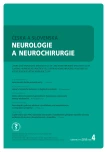Spinocerebellar Ataxia 6 – a Case Report
Authors:
K. Krakorová 1; J. Polívka 1; F. Šlauf 2
Authors‘ workplace:
LF UK a FN Plzeň
Neurologická klinika
1; LF UK a FN Plzeň
Klinika zobrazovacích metod
2
Published in:
Cesk Slov Neurol N 2015; 78/111(4): 482-485
Category:
Case Report
Overview
Spinocerebellar ataxia 6 (SCA6) is a rather rare neurodegenerative disorder, one of autosomal dominant spinocerebelar ataxias. It is caused by expansion of unstable CAG triplet repeats in the gene responsible for the voltage-dependent calcium channel mapped to the chromosome 19. The disease is characterized by progressive paleo - and neocerebellar symptomatology. The onset of the disease is typically in middle - and older-age. The authors describe a case of 62-year-old women with sudden development of gait deterioration. This was first diagnosed as a post-ischemic stroke state. However, clinical symptoms progressed into gait ataxia. No analogical case was found in family history. Genetic testing, performed after all other potential causes of the condition were excluded, indicated SCA6. Our case report emphasises the importance of considering rare conditions as part of differential diagnosis. In this case, this protected the patient from further diagnostic testing as well as, importantly, enabled predictive testing in relatives in risk.
Key words:
spinocerebellar ataxia – cerebellar syndrome – hereditary spinocerebellar degenerations
The authors declare they have no potential conflicts of interest concerning drugs, products, or services used in the study.
The Editorial Board declares that the manuscript met the ICMJE “uniform requirements” for biomedical papers.
Sources
1. Bird TD. Hereditary Ataxia Overview. Gene Reviews. [online]. Available from URL: http:/ / www.ncbi.nlm.nih.gov/ books/ NBK1138 .
2. Růžička E. Neurodegenerativní onemocnění mozku. In: Bednařík J, Ambler Z, Růzička E (eds). Klinická neurologie, část speciální I. 1. vyd. Praha: Triton 2010 : 700 – 707.
3. Schöls L, Bauer P, Schmidt T, Schulte T, Riess O. Autosomal dominant cerebellar ataxias: clinical features, genetics and pathogenesis. Lancet Neurol 2004; 3(5): 291 – 304.
4. Sequeiros J, Martins S, Silveira I. Epidemiology and population genetics of degenerative ataxias. Handb Clin Neurol 2012; 103 : 227 – 251. doi: 10.1016/ B978 ‑ 0 ‑ 444 ‑ 51892 ‑ 7.00014 ‑ 0.
5. Musova Z, Sedlacek Z, Mazanec R, Klempir J, Roth J, Plevova P et al. Spinocerebellar ataxias type 8, 12, and 17 and dentatorubro‑pallidoluysian atrophy in Czech ataxic patients. Cerebellum 2013; 12(2): 155 – 161. doi: 10.1007/ s12311 ‑ 012 ‑ 0403 ‑ 5.
6. Zumrová A, Kopečková M, Mušová Z, Křepelová A, Apltová L, Paděrova K. Autosomálně dominantní spinocerebelarní ataxie. Neurol Prax 2007; 8(5): 277 – 282.
7. Du X, Wang J, Zhu H, Rinaldo L, Lamar KM, Palmenberg AC et al. Second cistron in CACNA1A gene encodes a transcription factor mediating cerebellar development and SCA6. Cell 2013; 154(1): 118 – 133. doi: 10.1016/ j.cell.2013.05.059.
8. Zhuchenko O, Bailey J, Bonnen P, Ashizawa T, Stockton DW,Amos C et al. Autosomal dominant cerebellar ataxia (SCA6) associated with small polyglutamine expansions in the alpha 1A ‑ voltage ‑ dependent calcium channel. Nat Genet 1997; 15(1): 62 – 69.
9. Teive HA, Munhoz RP, Raskin S, Werneck LC. Spinocerebellar ataxia type 6 in Brazil. Arq Neuropsiquiatr 2008; 66(3): 691 – 694.
10. Soong BW, Paulson HL. Spinocerebellar ataxias: an update. Curr Opin Neurol 2007; 20(4): 438 – 446.
11. Baloh RW, Yue Q, Furman JM, Nelson SF. Familiar episodic ataxia: clinical heterogenity in four families linked to chromozome 19p. Ann Neurol 1997; 41(1): 8 – 16.
12. Ducros A, Denier C, Joutel A, Vahedi K, Michel A, Darcel F et al. Recurrence of the T666M calcium channel CACNA1A gene mutation in familial hemiplegic migraine with progressive cerebellar ataxia. Am J Hum Genet 1999; 64(1): 89 – 98.
13. Guidelines for the molecular genetics predictive test in Hungtington’s disease. International Hungtington Association (IHA) and the World Federation of Neurology (WFN) Research Group on Hungtington’s Chorea. Neurology 1994; 44(8): 1533 – 1536.
Labels
Paediatric neurology Neurosurgery NeurologyArticle was published in
Czech and Slovak Neurology and Neurosurgery

2015 Issue 4
Most read in this issue
- Therapy of Pudendal Neuralgia – Five Years of Experience
- The Contribution of Magnetic Resonance Imaging to the Diagnosis of Epilepsy
- Experimental Treatment of Spinal Cord Injuries
- TLIF Technique for Treatment of Foraminal Lumbar Disc Herniation in Isthmic Spondylolisthesis
